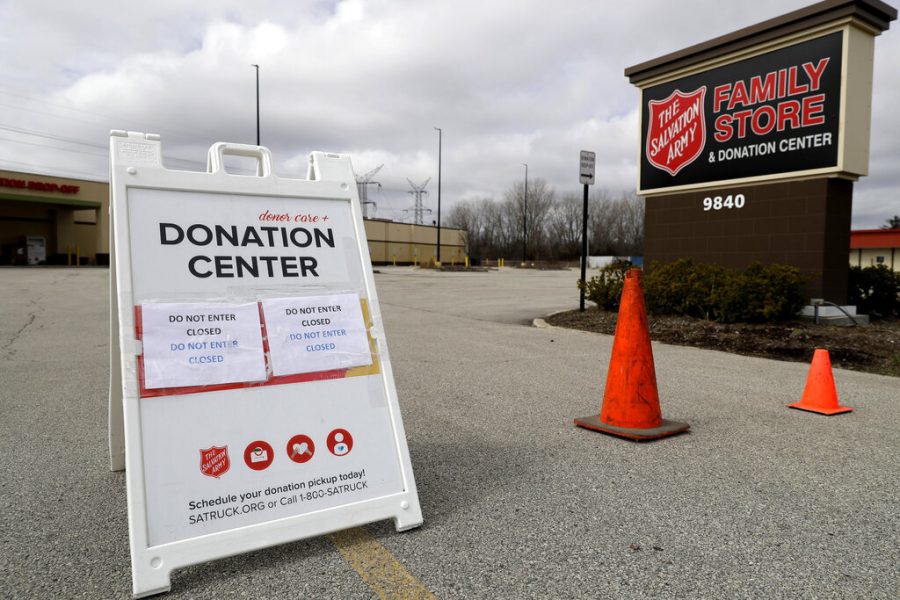Fast Fashion Is Out and Sustainability Is In
FILE – In this April 1, 2020 file photo, a closed sign is displayed outside a Salvation Army store and donation center in Glenview, Ill. Across the country, drug and alcohol recovery programs claiming to help the poor and the desperate are instead conscripting them into forms of indentured servitude, requiring them to work without pay or for pennies on the dollar, in exchange for their stay. For the first time, Reveal from The Center for Investigative Reporting has determined how widespread these programs have become. In 1990, in response to a complaint from a former participant, the Labor Department launched an investigation into the nation’s largest chain of work-based rehabs, The Salvation Army, which operates about 100 programs across the country. At The Salvation Army’s rehabs, participants were required to work full time processing donations for the organization’s thrift stores, receiving a stipend of only $5 to $20 a week. The department found The Salvation Army had violated labor laws and ordered the nonprofit to pay its participants minimum wage. The Salvation Army refused to comply. It sued, then enlisted members of Congress to defend the venerable charity. Within a month, the department backed off.(AP Photo/Nam Y. Huh, File)
As you pack away your oversized bulky sweaters and take out shorts and t-shirts, are you thinking about how your fashion choices affect the earth? Probably not. This year fashion sustainability is the trendiest style.
Sustainability within fashion is ensuring that your clothes are ethically sourced and durable. Since the start of the Covid-19 pandemic, there has been a significant increase in the consumption of fast fashion products.
Fast fashion is when companies mass produce trendy clothing at an astronomical rate for meager prices. The low prices may make a clothing brand seem more intriguing, especially to young students who are not financially thriving, but why these brands can price their clothes so low is more than criminal. Many fast fashion companies are outsourced from other countries where labor costs are much cheaper. Many hard-working people are being highly under-compensated for their work in an attempt for large businesses to attract more customers.
Many people, young and old, know this is a problem but don’t know how to create a more sustainable wardrobe. Research is the most important step when shopping for more sustainable and ethical clothing. The research will help you determine what aspects of clothing production are valuable to you and which are not. Here are three helpful ways to reduce your ecofootprint, get more extended wear out of your clothes, and ethically source them:
Thrifting
Although thrifting has been around for decades, thrifting clothes have become very popular amongst young people within the past few years. Thrifting is when you can buy previously owned clothes at a discounted price. Although these clothes are not usually new, most clothes that customers find are in perfect condition. Thrifting helps ensure that clothes get the most wear possible and helps those who cannot afford new clothes. Thrifting is considered popular nationwide and can ensure that customers are resourcefully buying clothes at an unbeatable price. Many local thrift stores donate proceeds to those in need, such as Laurel’s Loft- https://www.loc8nearme.com/pennsylvania/lansdale/laurels-loft/5035152/, Care & Share Thrift Shoppes, and Liberty Ministries Thrift.
Searching New Brands
One of the hardest parts of upgrading your wardrobe to an ethical and sustainable collection is that you feel like you’re missing out on shopping at trending stores that your favorite friends and influencers shop at. By sacrificing just a tiny amount of your time researching, you can find affordable, stylish, and sustainable clothing that will let you express your style. When searching for formal wear, brands like Quince or Able. Some of the more popular sustainable clothing brands are Levi’s and Patagonia. Wearing cute clothing doesn’t have to be at the hands of fast fashion.
The 30 Wears Rule
The 30 Wears Rule is a simple rule that will help minimize your spending and help keep your wardrobe small enough that all your clothes are sufficiently worn. Before purchasing, customers must ask themselves, “Can I see myself wearing this more than thirty times?” If the answer is yes, then the investment is valid, but if not, then there should be some reconsideration. The 30 Wears Rule can be applied to much more than just clothing and is a helpful reminder not to overspend to save money and ensure your purchases are ethically sourced.
One of the most eco-friendly choices you can make this spring is avoiding fast fashion. With just these few helpful tips followed by many more you could find with some research, it will be easy to dress to impress this upcoming spring.


